OpenAPI 3.0 规范-食用指南
作者:互联网
概述
OpenAPI 3.0 规范由 8 个根对象组成:
- openapi
- info
- servers
- paths
- components
- security
- tags
- externalDocs
OpenAPI 的其余功能都是基于这 8 根对象扩展而成,凡是包含以上对象并且扩展名为 json,yaml 的文件,我们可以将其视为符合 OpenAPI 规范的描述文件 ,你可以在:API Editor 在线编辑器 中来验证你的 OpenAPI 文件是否符合规范,以下我们就主要介绍 8 个根对象的使用和扩展方法
openapi 对象
openapi 是最简单也是最基础的属性,我们为 OpenAPI 添加第一个根对象属性,指定使用的规范版本:
openapi: "3.0.2"
然后继续补充信息
openapi: "3.0.2"
info:
title: openAPI Demo
version: '1.0'
paths: {}
一个极简的 OpenAPI 文件就诞生了,它的展示方式如下:

- 上面灰色的 1.0 是指你 server 的版本
- OAS3 指的是你所使用的 OpenAPI 规范的版本
info 对象
根节点的 info 对象主要包含以下信息:
- title: 标题
- description: API 描述
- version:版本号
- license:许可证信息
- contact:联系人信息
- terms of service:服务条款
以下是 info 对象和属性的示例:
openapi: "3.0.2"
info:
title: openAPI Demo
description: "This is an API program for teaching"
version: '1.1'
termsOfService: "https://openweathermap.org/terms"
contact:
name: "api developer"
url: "http://myblog.cn"
email: "youemai@gmail.com"
license:
name: "Apache 2.0"
url: "http://springdoc.org"
paths: {}
以上内容的预览效果如下:
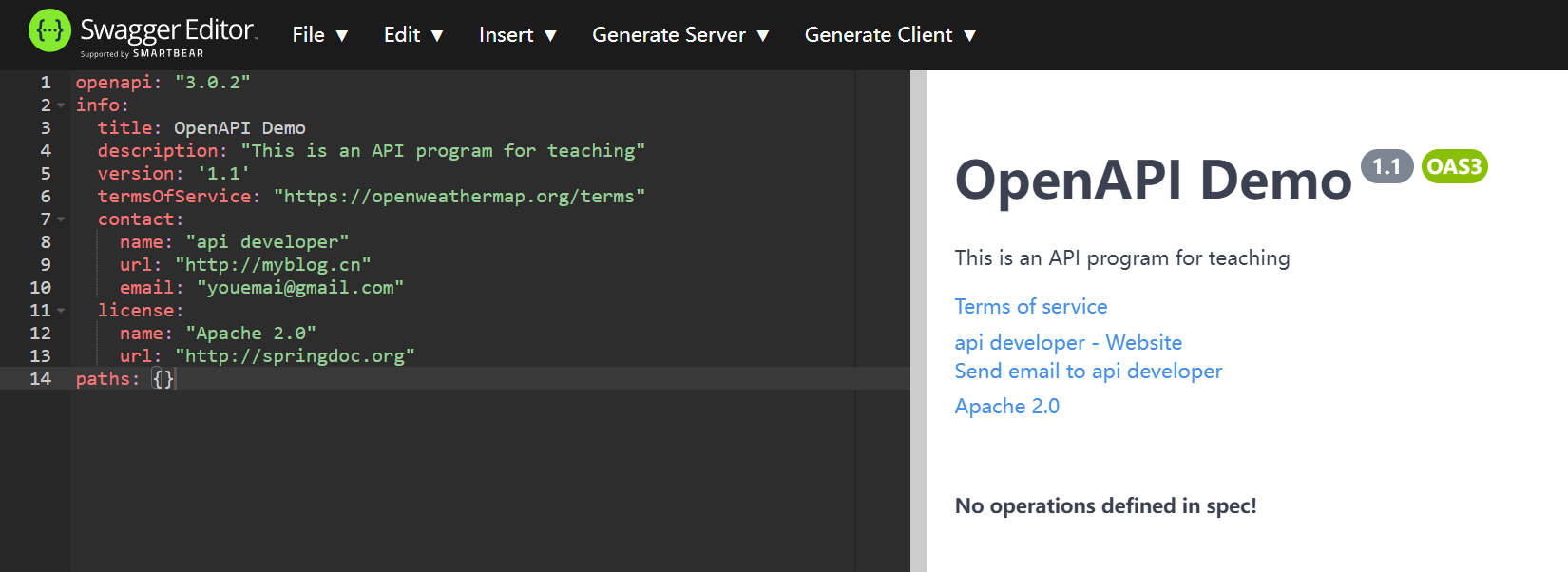
如果觉得 description 太过简陋,它也支持 Markdown 语法显示,效果如下:

按照约定 description 应该向用户展示如下信息:
- 描述整个 API 和如何使用它
- 为用户提供测试账号和数据
- 其他任何用户需要的信息都可以通过它来提供
servers 对象
servers 主要表示访问服务端的基础路径,既在访问接口前都会带上该参数,示例如下:
servers:
- url: 'http://localhost:8080/webapi'

servers 对象支持多参数配置,你可以指定多服务器(开发,测试,生成等)的 URL,用户可以从下拉框选择不用服务器的 URL 发起请求,配置和预览效果如下:
servers:
- url: https://localhost:8080/webapi
description: develop server
- url: http://test-server:8080/webapi
description: test server
- url: http://product-server:8080/webapi
description: product server

paths 对象
paths 对象包含真正的 API 信息内容,它的每个项都包含一个可操作的 endpoint 操作对象,每个操作对象都包含我们常见的 GET/POST/PUT/DELETE 等方法,看一个简单示例:
paths:
/pet:
get:
以上信息描述一个 /pet 的 endpoint ,它只包含一个 get 操作对象,类似 get 操作对象(也称 Operation Objects)也包含以下属性:
tags:用于对 endpoint 进行分组的组名summary:操作对象的摘要信息,最好限制在 5-10 字以内,主要作为概览展示description:操作对象的描述信息,尽可能的详细,展示细节信息operationId:操作对象的唯一 IDparameters:该端点的请求参数对象,描述如下,(requestBody描述不在此列包含系列属)- name:参数名称
- in:参数出现的位置,通常是
header,path,query,cookie - description:参数的描述(支持 markdown)
- required:必填项
- deprecated:是否弃用
- allowEmptyValue:允许提交空值
- style:参数序列化方式
- explode:与数组相关的参数
- schema:参数的模型
- example:媒体类型的示例
requestBody:请求主体的描述,还可以包含一个指向components的$ref指针response:响应主体的描述,通常使用标准的 HTTP 状态码,可以包含指向components的$ref指针callbacks:回调对象和回调信息的描述,较为少见,不过多介绍deprecated:标识该path是否被弃用security:仅用于覆盖全局的安全授权方法servers:仅用于覆盖全局的服务器访问对象
大多数情况下不需要声明那么多的属性,以下是一个端点的 operation object 常见描述信息,如下:
paths:
/weather:
get:
tags:
summary:
description:
operationId:
externalDocs:
parameters:
responses:
parameters 对象
parameters 的示例用法(包含一个参数的 get 方法):
paths:
/weather:
get:
tags:
- Current Weather Data
summary: "Call current weather data for one location."
description: "^_^"
operationId: CurrentWeatherData
parameters:
- name: q
in: query
description: "^_^"
schema:
type: string
responses 对象
responses 用于描述接口的响应对象,可以直接描述,如下:
responses:
200:
description: Successful response
content:
application/json:
schema:
title: Sample
type: object
properties:
placeholder:
type: string
description: Placeholder description
404:
description: Not found response
content:
text/plain:
schema:
title: Weather not found
type: string
example: Not found
你可以在 Swagger UI 中看到以下的示例效果:
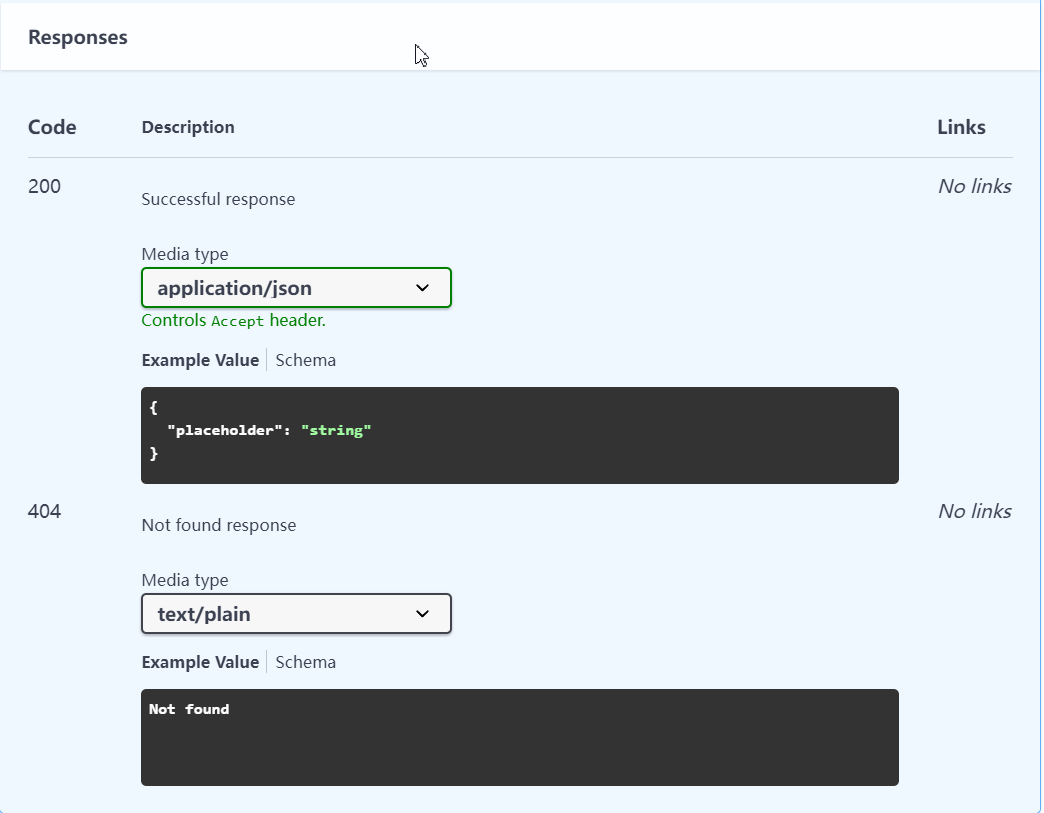
components 对象
在 components 中主要可以定义重复使用的对象,以便其他对象使用 $ref 关键字直接引用和声明
在 parameters 中重用对象
我们可以把刚才对 parameters 的描述移动到 components 中来,如下:
components:
parameters:
q:
name: q
in: query
description: "………………"
schema:
type: string
id:
name: id
in: query
description: "…………"
schema:
type: string
lat:
name: lat
in: query
description: "………………"
schema:
type: string
然后我们可以在 paramters 中直接引用它,如下:
paths:
/weather:
get:
tags:
- Current Weather Data
summary: "………………"
description: "………………."
operationId: CurrentWeatherData
parameters:
- $ref: '#/components/parameters/q'
- $ref: '#/components/parameters/id'
- $ref: '#/components/parameters/lat'
responses:
200:
description: Successful response
content:
application/json:
schema:
title: Sample
type: object
properties:
placeholder:
type: string
description: Placeholder description
404:
description: Not found response
content:
text/plain:
schema:
title: Weather not found
type: string
example: Not found
如上,利用好 components 就可以达到组件复用 +减少篇幅的效果
在 reponses 中重用对象
我们也可以直接在 reponses 中引用已经声明的对象,如下:
responses:
200:
description: Successful response
content:
application/json:
schema:
$ref: '#/components/schemas/200'
它在 yaml 中的描述如下:
components:
schemas:
200:
title: Successful response
type: object
properties:
base:
type: string
description: Internal parameter
example: cmc stations
visibility:
type: integer
description: Visibility, meter
example: 16093
dt:
type: integer
description: Time of data calculation, unix, UTC
format: int32
example: 1435658272
id:
type: integer
description: City ID
format: int32
example: 2172797
name:
type: string
example: Cairns
cod:
type: integer
description: Internal parameter
format: int32
example: 200
它在 Swagger UI 中展示效果如下:
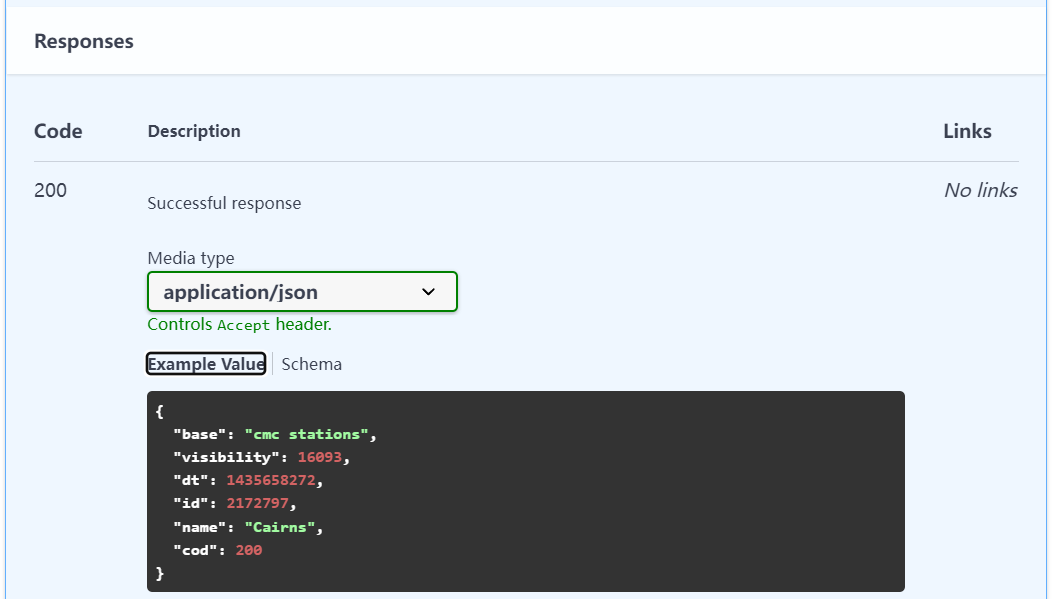
在 schemas 中展示
通过 components 定义的对象都会在 Swagger UI 下方通过 Schemas 进行展示,如下:
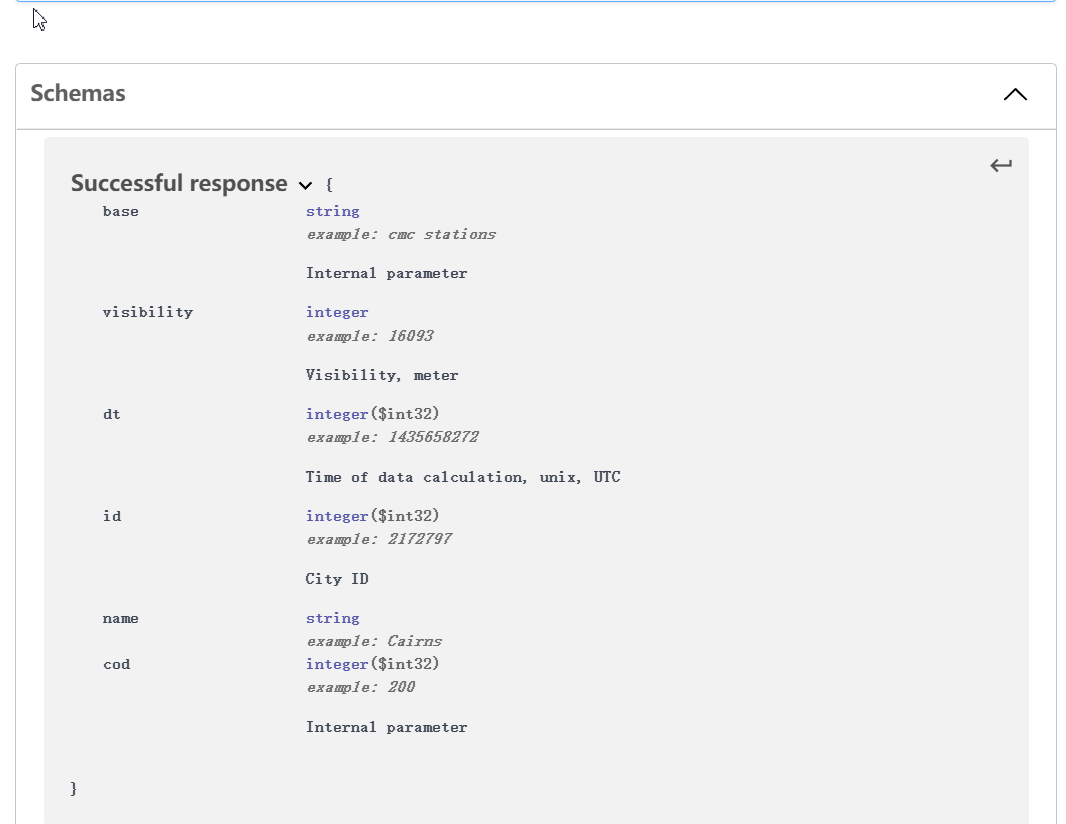
security 对象
除了部分 Demo 示例外,大部分的 Web 服务都是需要经过身份认证的才能访问,security 就是用于描述 API 的安全信息和访问授权协议等信息的对象,OpenAPI 支持最常见的四种授权方案,如下:
- API key
- HTTP
- OAuth 2.0
- Open ID Connect
这里我们使用最常见的 API Key 作为演示,在 OpenAPI 文档的根目录添加安全对象:
security:
- app_id: []
这样所有的路径都会使用 security 描述的 app_id 安全方法,但是通常会在 components 中添加 security 对象,这样的描述信息会更加的详细,如下:
components:
...
securitySchemes:
app_id:
type: apiKey
description: API key to authorize requests.
name: appid
in: query
security 对象的属性内容:
- type:授权协议,枚举值有:
apiKey、http、oauth2、openIdConnect - description:安全方法的描述,尽可能的详细,包含使用示例
- name:安全密钥
apiKey在 HTTP Header 请求中的名字 - in:安全密钥
apiKey在 HTTP 传输中的位置,枚举值有:query,header,cookie - …………
在添加以上的描述信息后,Swagger UI 会显示安全任何的相关标识,如下:
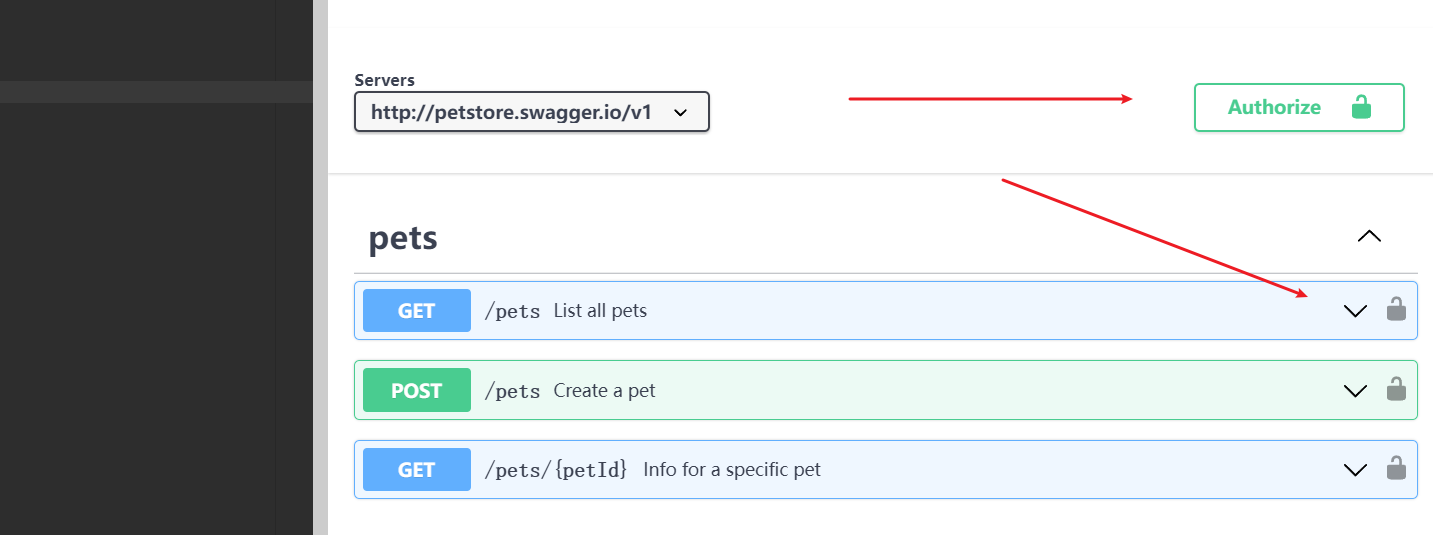
点击 Authorize 会显示更多的安全信息:

当你在 Value 输入你的访问秘钥时,Swagger 会在访问 API 的时候,根据你的设定访问你的 API,如下:
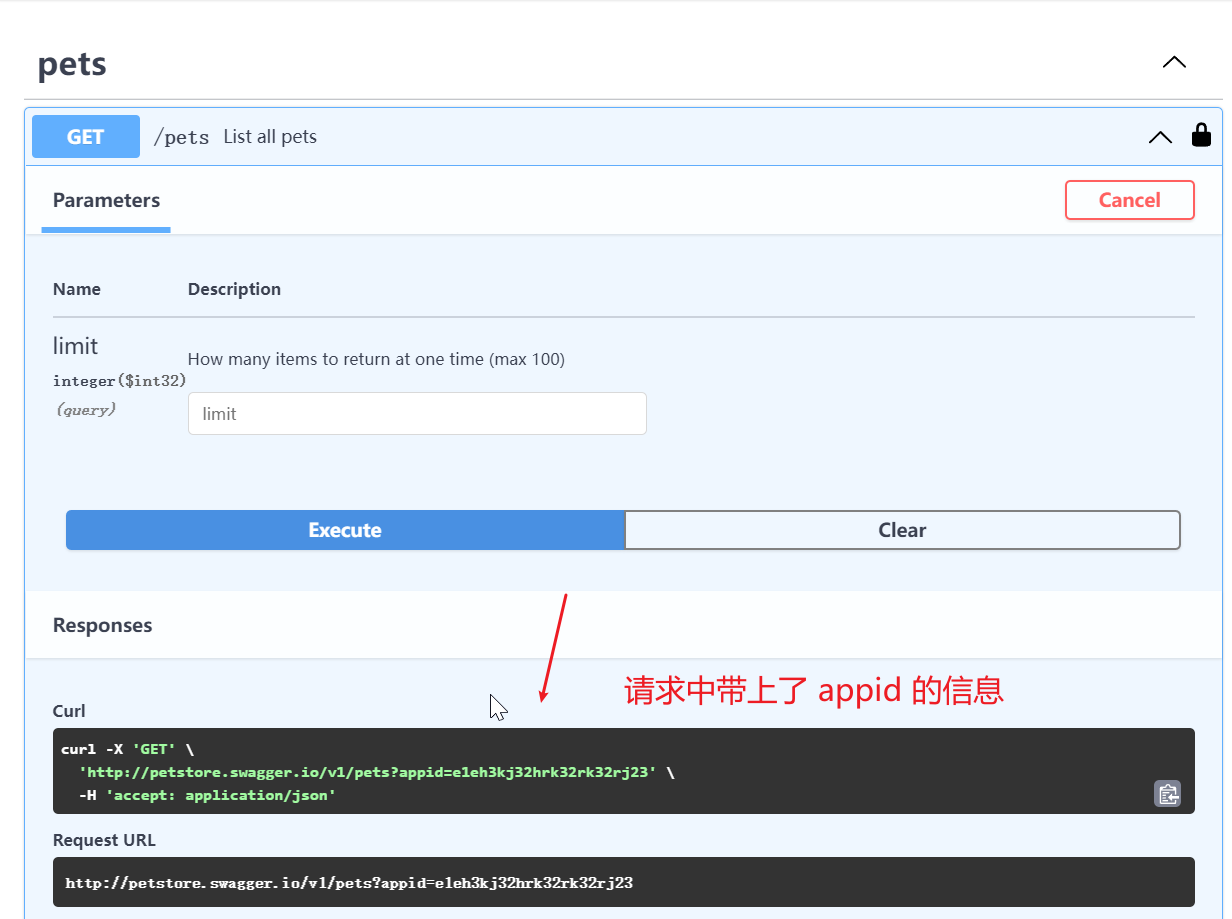
tags 对象
该对象主要是对 OpenAPI 中的多个访问路径进行分组,从而更方面的查看 API 信息,使用示例如下:
我们为一个请求路径添加 tags 信息:
paths:
/pets:
get:
summary: List all pets
operationId: listPets
tags:
- pets
这表示该请求路径属于 pets 分组,然后我们在根目录级别添加 tags 属性,来为分组信息进行描述:
tags:
- name: pets
description: "Chimelong Animal Happy World"
然后我们来看看 Swagger UI 对于分组信息的展示,如下:

externalDocs 对象
该对象不常用,主要添加对外部文档的引用,来对目前文档进行补充,例如你可以在根目录添加该属性,如下:
externalDocs:
description: externalDocs API Documentation
url: https://openweathermap.org/api
它会在你 Swagger 的描述中展示一个链接地址,如下:

你还可以在 API 的请求路径中,增加一个外部引用的描述,如下:
paths:
/pets:
get:
summary: List all pets
externalDocs:
description: externalDocs API Documentation
url: https://openweathermap.org/api
Swagger UI 会在请求路径的描述中,增加一个外部链接作为对描述的补充,如下:
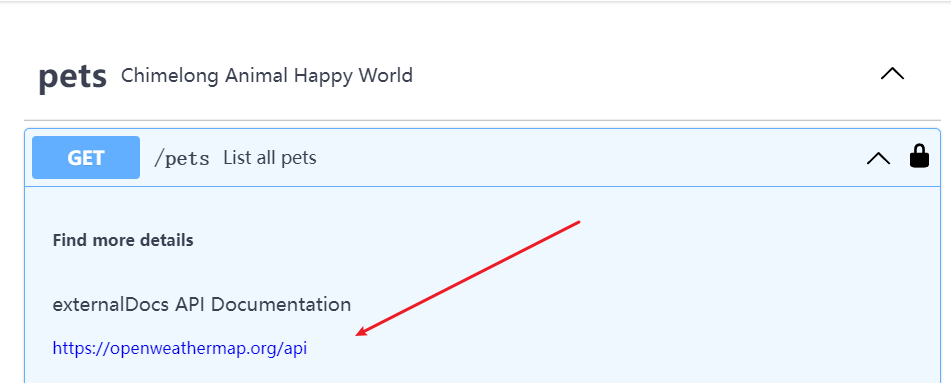
总结
以上就是一个完整的 OpenAPI 规范的文件的使用说明
参考资料:
- OpenAPI tutorial using Swagger Editor and Swagger UI: Overview OpenAPI 不错的教程
- OpenApi Openweathermap Example File 完整 OpenAPI 规范文件
- Swagger Editor Swagger 提供的在线编辑 OpenAPI 文件工具
标签:指南,description,对象,components,OpenAPI,API,3.0,type 来源: https://www.cnblogs.com/xiao2shiqi/p/16412813.html